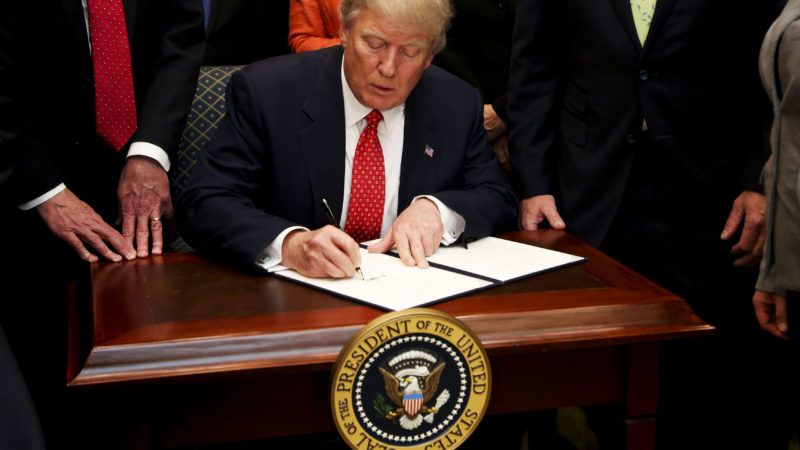The Pandemic Is a Reminder That Many Regulations Are Both Costly and Unnecessary
It took a crisis for policymakers to see that hundreds of rules were not worth the burdens they imposed.

If there is one thing the coronavirus pandemic has shown, it's that regulation gets in the way.
Americans for Tax Reform, a conservative non-profit that advocates for lower taxes, has compiled a running—and growing—list of federal and state rules and regulations relaxed or suspended during the crisis. As of this writing, the list is up to 561 regulations. Unsurprisingly, many of the rollbacks are specifically related to the provision of health care services, one of the most heavily regulated sectors of the economy. But the regulatory rollbacks span the gamut, from legalizing cocktails to-go and relaxing rules governing distillery production of hand sanitizer to small business lending reforms to allowing "remote marriage" in a number of states.
Each of these rules formerly made it more difficult to conduct one's business or personal affairs, and each made it more difficult to respond, or merely live, in a pandemic. It's both sad and telling that it took a unique global health crisis for policymakers to decide that they were not worth the costs they imposed.
One reason why is that the costs of regulation are not always obvious. The nature of rulemaking is to impose hidden costs, especially when, at the federal level, the writing of regulations is largely delegated to executive branch agencies not subject to the same budgetary processes and pressures that govern Congress.
Instead, to calculate the cost of these sorts of rules, we must turn to independent estimates like The Ten Thousand Commandments, an annual survey of the cost of the federal regulatory state produced by Clyde Wayne Crews, the vice president for policy at the Competitive Enterprise Institute, a libertarian think tank.
The latest edition of the report, out today, tabulates the total yearly cost of federal regulation at $1.9 trillion. That's equal to about 9 percent of the total national economy. In addition, the federal government spent about $72 billion to administrate these rules, according to an estimate by The Weidenbaum Center at Washington University in St. Louis and the George Washington University Regulatory Studies Center in Washington, D.C. That breaks down to an average of about $14,000 per household annually. If it were a tax, the total burden would be larger than all corporate and personal income taxes combined.
The majority of these rules come from just a handful of federal agencies, according to the report: The Departments of Commerce, Defense, Health and Human Services, the Interior, Transportation, the Treasury, and the Environmental Protection Agency, which together account for a little more than half of all conventional federal regulations. It is not too hard to see the impact these agencies have on nearly every aspect of life: Although unelected, they have become de facto lawmaking entities, setting legally enforceable rules whose costs Congress never explicitly considered. On average, in 2019, each federal law resulted in 28 new rules—up from 11 per law in 2018.
Courts, meanwhile, have adopted a doctrine that amounts to presumptive deference to agency interpretations of rules under which any "rational basis" will do. Federal agencies not only get to make rules that act as laws, they are granted considerable leeway to decide what those rules mean.
CEI has been tabulating these costs since 1993; since then, federal agencies have issued more than 107,000 rules. President Trump has, to his credit, taken steps to reduce the flow of federal regulation, implementing a two-in, one-out rule. But even that effort is slowing, with the Trump administration claiming only 1.7 rules "out" for every one rule "in" in 2019.
And Trump's own impulses threaten his successes: As Crews writes, the president "has pruned rules and costs and held down regulatory output with more enthusiasm than other presidents," but his administration has also pushed forward with new rules concerning antitrust, hospital pricing, social media regulations, trade restrictions, vaping, farming and agriculture, the telecom industry, immigration, and more. "When all is said and done," the report concludes, "the administrative state cannot be said to have fundamentally changed under Trump."
The same can be said about the regulatory rollbacks spurred by the coronavirus. Although some rule changes are likely to be made permanent, the various governmental pipelines that produce them are likely to remain in place, and, in some cases, empowered. Still, the hundreds of rollbacks are a reminder of the myriad regulations that rule and restrict our lives every day—how onerous they are, how unnecessary, and how easy it is to live without them.
Disclosure: I worked at the Competitive Enterprise Institute from 2005 through 2007.


Show Comments (43)